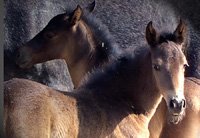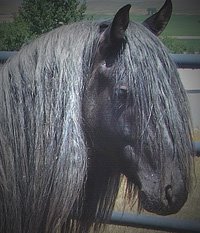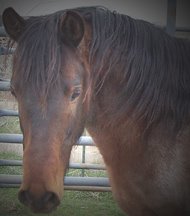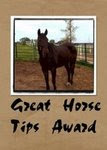
"We have our answer," Aaruba's vet announced when I answered the phone. "He has ulcers."
I sighed in relief. "Good!"
Ummm...Why am I so pleased that my beloved horse has lesions in the lining of his stomach?
Well, the bad news is good news because it answers a lot of questions: Why has Aaruba suffered recurrent, mild colics? Why do I have such difficulty keeping weight on him, though he has access to hay 24/7? Why is he brilliant some days and lethargic others? Why does he sometimes fail to clean up his feed? Now we know.
It's also good news because ulcers are curable. Not cheap, but curable. This is a huge relief, as another possibility suggested was that of permanent parasite damage left over from Aaruba's youth.
You can't live among performance horses for long and not encounter one with gastric ulcers. Many sources claim that about 60% of equine athletes suffer from ulcers. The percentage of affected horses tends to rise with increased training and competition; at an estimated 90%, racehorses top the list for ulcer risk.
In equines, gastric ulcers are caused by excessive acidity in the stomach. A horse's stomach produces about 1.5 litres of acidic fluid per hour. Ideally, this acid is neutralized by the alkalinity of a horse's saliva. However, saliva is only produced when the horse eats.
Do you see where this is going? Horses that don't have constant access to forage are unable to follow their natural eating pattern of consuming small amounts of food at frequent intervals. Long periods without forage result in inadequate saliva production, which results in highly acidic gastric PH levels, which can result in gastric ulcers.
So, will offering your horse free-choice hay or pasture eliminate the possibility of ulcers? Unfortunately, no -- just ask Aaruba, who enjoys a free-choice, 60/40 grass/alfalfa mix. While constant or frequent access to forage dramatically decreases ulcer risk, other factors are also at play:
1) Stress. Whether the result of buddy-sourness, competition, travel, training, or other causes, stress increases gastric ulcer risk in horses, just as it does in humans. Some horses (Aaruba among them) are more prone to stress than others. Performance horses will, obviously, face stressors as an unavoidable part of their jobs.
2) Exercise. Research demonstrates that increased exercise equals increased ulcer risk in equines. The reason for this are unclear, though some suggest it is a combination of elevated stress levels and extended periods with limited feed intake.
3) Feed concentrates. Grains and other concentrated feeds stimulate increased stomach acid production. Obviously, this problem is exacerbated if the horse cannot follow his grain consumption with plenty of forage.
As you can see, the lives of many equine athletes are perfect recipes for the development of gastric ulcers. The problem is often overlooked, however, because the symptoms can be quite subtle. Here's what to look for:
1) Acute or recurrent colic symptoms, often mild and responsive to Banamine. This was a major tip-off in Aaruba's case.
2) Weight loss or persistent poor condition. This was Aaruba's other significant symptom -- despite access to abundant feed, he struggled to attain the fat layer appropriate for an endurance athlete. Some horses also show decreased hair coat quality.
3) Decreased appetite or a tendency to walk away from a half-finished meal.
4) Compromised performance. In hindsight, I believe many of Aaruba's less energetic workouts could be attributed to his ulcers.
5) Reduced manure output or, less commonly, diarrhea.
6) Attitude and behavior changes such as increased nervousness, irritability, or biting/mouthiness.
If these symptoms sound familiar, what should you do? Aaruba's vet offered two courses of action -- either have the horse scoped to determine conclusively whether ulcers are present, or simply medicate the horse and rely on the cessation of symptoms to give us an answer.
Easy choice, right? Not really. Scoping costs around $250 or $300, but the drug of choice, GastroGard, runs at least $28 per tube (I've heard of prices up to $75 per tube!) -- and the dosage for most horses is one full tube per day for 30 days. That's a lot to pay for medication you aren't sure your horse needs. It's true that horses may show signs of improvement after just a few days on GastroGard, but this is inconclusive as ulcer symptoms often come and go even in the absence of medication.
GastroGard can be purchased online for lower prices than you're likely to find at your local vet, but it does require a prescription. Non-prescription UlcerGard is the same drug (Omeprazole) labeled as a preventative medication rather than a cure. At first glance, UlcerGard appears less expensive than GastroGard; however, this is because the recommended dosage (for prevention) is 1/4 the dosage required to actually resolve existing ulcers. Using enough UlcerGard to cure ulcers costs about the same as using GastroGard, so I'm sticking with my vet's recommendation to order the name brand.
What about recurrence? Gastric ulcers can certainly recur after treatment, but preventative measures can be taken to keep an ulcer-prone horse like Aaruba healthy even during the stress of continued athletic endeavors. In addition to employing our usual management strategies to keep him as calm as possible, we'll keep Aaruba on preventative medication and remove all grain from his diet, replacing it with Purina Equine Senior.
Keep an eye on your horses, friends, and don't be afraid to delve into possible causes of that niggling concern. You might just get some good bad news of your own.
______________________________________________
Related Posts
Introduction: Equine Gastric Ulcer Series
Strategies for Prevention of Equine Gastric Ulcer Syndrome
Pharmaceutical and Alternative Treatment Options for Equine Gastric Ulcer Syndrome
Equine Ulcer Supplement Options
EGUS, Endurance, and the AERC
A Fair Question: Equine Athletes, Equine Ulcers
Bringing it Home: EGUS Prevention at In the Night Farm
Sheer Brilliance: Aloe and MSM as Alternative Therapy for EGUS
Q & A: Aloe and MSM as Alternative Therapy for EGUS
______________________________________________
Did you enjoy this post? We deliver!
Subscribe to The Barb Wire
____________________________
The photo accompanying this post is by equine sculptor Lynn Fraley. Be sure to take A Virtual Visit to Laf'n Bear Studio!









1 comment:
Fascinating! Thank you for the detailed report on equine ulcers.
Post a Comment